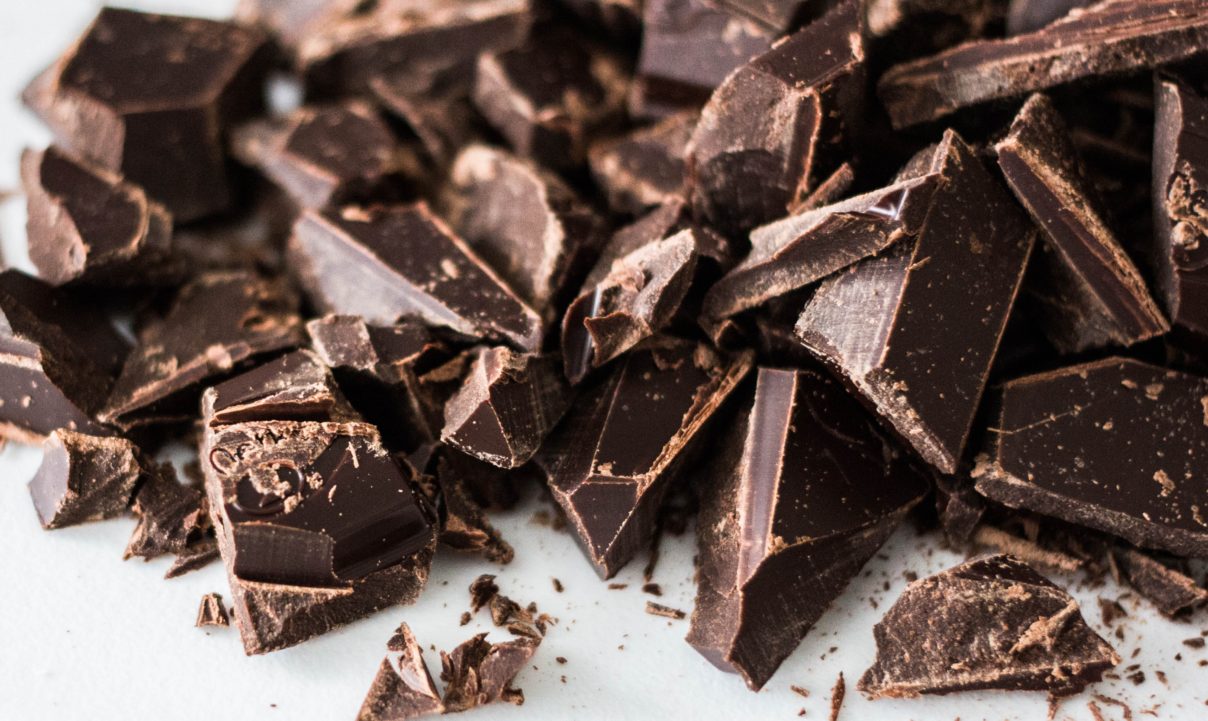Chocolate choices

Dr Lindsay Macnaughton, Assistant Professor in our Department of Sport and Exercise Sciences, analyses what we should consider when choosing chocolate.
If you like chocolate, you will know that the choice can be overwhelming! With so many brands, types, fillings, sizes, the options seem endless. Everyone has their favourite, but have you ever stopped to think what is in your chocolate and where it comes from?
Nutritionally, not all chocolate is equal, and it might be worth taking a closer look at what is inside. To keep things simple let’s consider chocolate without fillings or extra added tasty bits, otherwise we could be here all day! The cocoa content of chocolate is the main factor that alters its nutritional profile. Cocoa beans contain polyphenols which are compounds found in plants that act as antioxidants (Manach, et al. 2004). Antioxidants help to delay cell damage caused by free radicals (unstable molecules that cause oxidative stress) in our bodies. The specific type of polyphenols found in cocoa are called flavanols (Scalbert and Williamson, 2000). Consumption of these flavanols in cocoa have been linked potential health benefits, including reduced blood pressure (Ried, et al., 2017). Sounds good doesn’t it – chocolate with potential health benefits. But (there always a but!) unfortunately the amount needed for these benefits is higher than tends to be found in most chocolate, even with higher cocoa content.
Generally, chocolate with higher cocoa will have more flavanols (Miller, et al., 2009). So dark chocolate contains more flavanols than milk chocolate and both contain more than white chocolate, which has no flavanols at all (Langer, et al., 2011). Dark chocolate also contains less sugar than milk or white chocolate. These reasons might be why dark chocolate has been often portrayed as having health benefits. However, while it contains less sugar and more flavanols than milk or white chocolate, moderate amounts of dark chocolate doesn’t contain enough flavanols to gain the associated health benefits (Vlachojannis, et al., 2016) and is still high in sugar and fat which could contribute to the overconsumption of these nutrients. Chocolate can still be enjoyed in small amounts as part of a healthy balanced diet. So perhaps instead of considering what type of chocolate to have we should be considering how much to have. Dark chocolate can be good in this sense as most people would struggle to eat a comparable amount of dark chocolate to that of milk or white chocolate. So that could be a good strategy if you are trying to moderate your chocolate intake. While this blog’s focus is on what is inside chocolate from a nutrition perspective, we all need to be more aware and considerate of where our chocolate comes from and ensure we are informed to make responsible decisions regarding our chocolate choices.
References
- Manach C, Scalbert A, Morand C, Rémésy C, Jiménez L. Polyphenols:
food sources and bioavailability. Am J Clin Nutr. 2004 May;79(5):727-47. doi:
1093/ajcn/79.5.727. PMID: 15113710. - Scalbert A, Williamson G. Dietary intake and bioavailability of
J Nutr. 2000 Aug;130(8S Suppl):2073S-85S. doi:
10.1093/jn/130.8.2073S. PMID: 10917926. - Langer S, Marshall LJ, Day AJ, Morgan MR. Flavanols and
methylxanthines in commercially available dark chocolate: a study of the
correlation with nonfat cocoa solids. J Agric Food Chem. 2011 Aug
10;59(15):8435-41. doi: 10.1021/jf201398t. Epub 2011 Jul 11. PMID: 21699218. - Ried K, Fakler P, Stocks NP. Effect of cocoa on blood pressure.
Cochrane Database Syst Rev. 2017 Apr 25;4(4):CD008893. doi:
1002/14651858.CD008893.pub3. PMID: 28439881; PMCID: PMC6478304. - Miller KB, Hurst WJ, Flannigan N, Ou B, Lee CY, Smith N, Stuart
Survey of commercially available chocolate- and cocoa-containing products
in the United States. 2. Comparison of flavan-3-ol content with nonfat cocoa
solids, total polyphenols, and percent cacao. J Agric Food Chem. 2009 Oct
14;57(19):9169-80. doi: 10.1021/jf901821x. PMID: 19754118. - Vlachojannis J, Erne P, Zimmermann B, Chrubasik-Hausmann S. The
Impact of Cocoa Flavanols on Cardiovascular Health. Phytother Res. 2016
Oct;30(10):1641-1657. doi: 10.1002/ptr.5665. Epub 2016 Jul 1. PMID: 27363823.
Find out more
- If you would like to find out more about Dr Lindsay Macnaughton and her work, visit her profile.
- We are ranked in the top 100 in the QS World University Rankings by Subject 2022. We are an outstanding place for excellence in teaching and research, and our students are highly employable. Visit our Department of Sport and Exercise Sciences webpages to discover more.
- If you’d like to share your story or insights into your work, visit our Submit a blog or vlog page to learn more.
